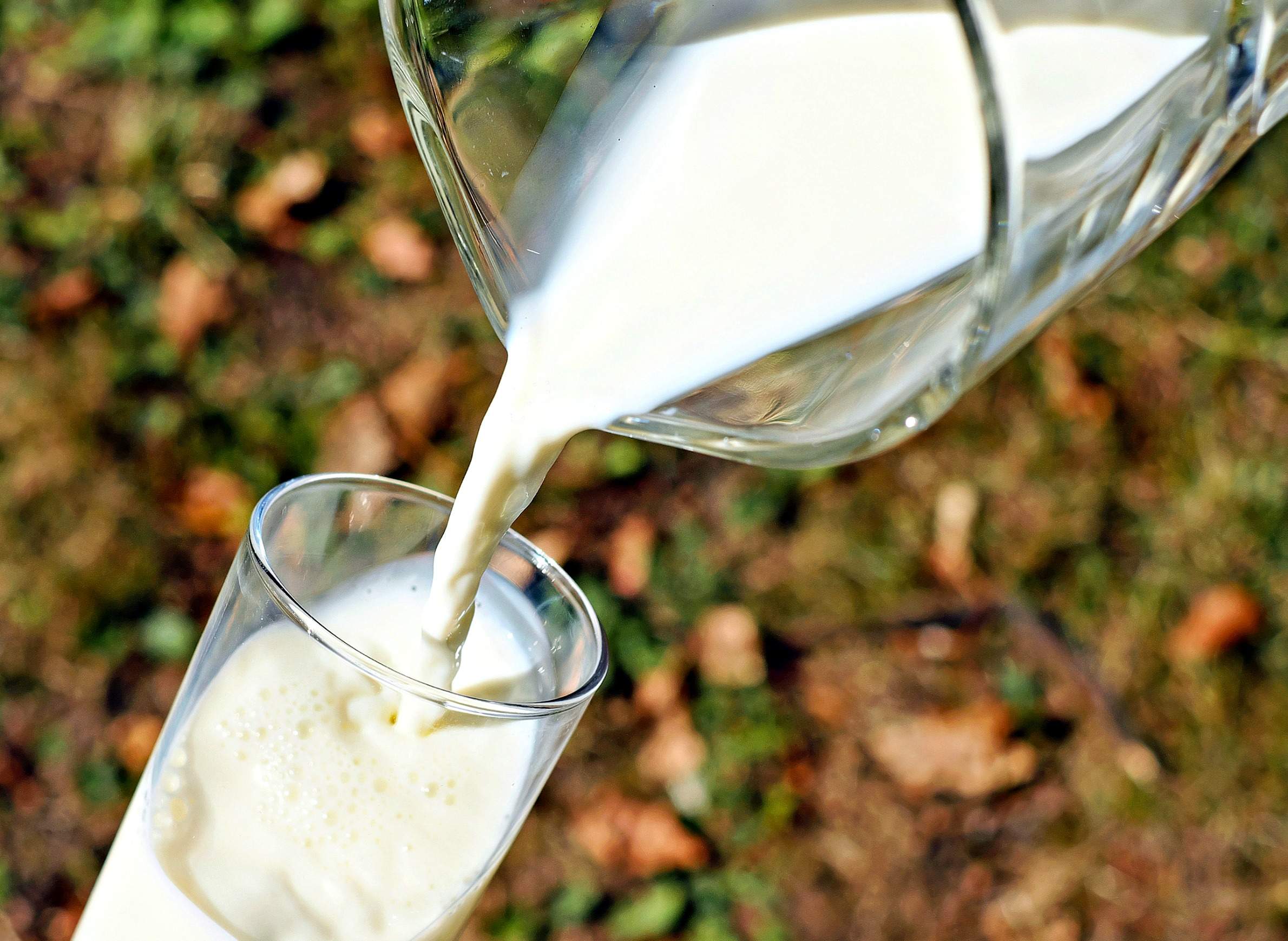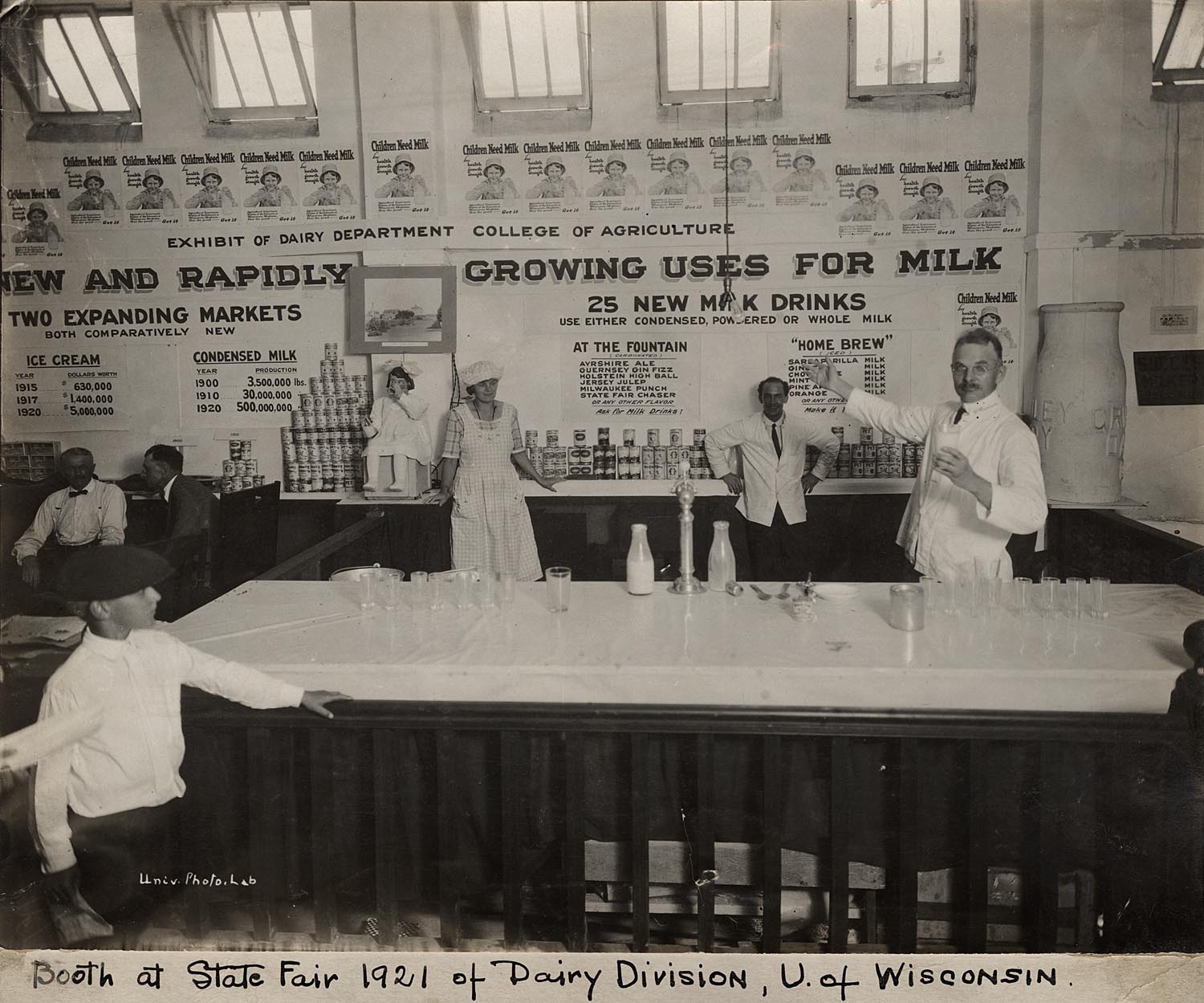
Dairy Defends Its Turf Over The Definition Of Milk

To create the concept of "milk" as people know it today, the U.S. dairy industry exerted considerable energy — spending a lot of money to develop new technologies and build political clout.
An early focus was butter. Starting in the late 19th century and continuing well into the 20th, federal and state laws regulated the color of margarine and in some cases prohibited it outright. In Wisconsin, a ban on this butter substitute, also called oleo, led to people smuggling it across state lines.
Milk direct from the cow would come into its own as well. By adopting widespread pasteurization and homogenization techniques later in the 20th century, the dairy business made milk safer and more affordable, and created the infrastructure to produce it on a truly mass-market scale. At the same time, the federal government and industry developed a marketing relationship to promote dairy products as part of a balanced diet — and to address surplus in the market. To this day, the industry helps fund the U.S. Department of Agriculture's Dairy Program, which supports the research of new products and helps spread the word about milk's nutritional bona fides.
Dairy's latest campaign focuses on the definition and labeling of milk. In December 2016, 32 members of the House of Representatives signed a letter urging the U.S. Food and Drug Administration to bar plant-based drinks like those commonly called soymilk and almond milk from being labeled as "milk." The bipartisan group included six of Wisconsin's eight U.S. Representatives — Sean Duffy, Glenn Grothman, Ron Kind, Mark Pocan, Jim Sensenbrenner and the outgoing Reid Ribble. Representatives Peter Welch, D-Vermont and Mike Simpson, R-Idaho, spearheaded the effort; Welch condemned "fake milk" in a press release issued the same day as the letter.
The legislators cited a "serious financial crisis" facing dairy farmers amid several years of falling prices. They wrote: "[M]arket forecasts predict that the dairy industry will continue to face depressed prices in the immediate future. Unless more is done, many more farmers will be forced to sell their herds."
Milk prices have decreased in recent years, due in part to record production and a drop in international demand. In response, the USDA purchased tens of millions of dollars of cheese for food banks and nutrition assistance programs over the latter half of 2016 to help address the surplus. By the end of the year, though, milk prices were increasing once again, though they were still nowhere near levels seen in 2014.
This campaign took another step on Jan. 12, when U.S. Senator Tammy Baldwin, a Democrat from Wisconsin, introduced a bill that would put the letter's request into law. Titled the "Defending Against Imitations and Replacements of Yogurt, milk, and cheese to Promote Regular Intake of Dairy Everyday Act" — that is, the DAIRY PRIDE Act — this bill (S.130) would limit the labeling of food products made from nuts, seeds, plants and algae.
"Imitation products have gotten away with using dairy's good name for their own benefit, which is against the law and must be enforced," said Baldwin in a press release. "Mislabeling of plant-based products as 'milk' hurts our dairy farmers."
The legislators' central argument is that the FDA isn't enforcing its current rules, which define milk as "the lacteal secretion, practically free from colostrum, obtained by the complete milking of one or more healthy cows." These regulations say nothing of other animal milks — such as sheep, goat, yak and reindeer — that remain very limited niche products and have not achieved anywhere near the market reach of plant-based milks. Nor does the legislators' letter mention other animal milks.
This issue is not new, as the dairy industry faces increasing competition from milk alternatives. A 2010 request by the National Milk Producers Federation for labeling enforcement went nowhere.
Dairy is not on the ropes
Over the past several years, almond milk surpassed soymilk as the biggest-selling plant-based milk in the U.S. and has kept growing. The research firm Nielsen reported in March 2016 that almond milk sales have continued to grow as dairy milk sales gradually decline. However, it still doesn't come anywhere close to the sales of dairy milk, said Molly Spence, head of North American marketing for the Almond Board of California.
The relationship between the almond and dairy industries isn't antagonistic — Spence points out that in California, almond shells and hulls are shipped to dairy farms in the state for use as feed and bedding.
"I don't know what the dairy industry is really trying to accomplish in consumers' minds," she said, referring to the legislators' letter to the FDA. "Even if they won on the regulatory front, I don't think they would win on the consumer front."
Dairy is expanding its reach, in fact. Americans are drinking less milk than they used to, but they're eating much more cheese and yogurt — enough that overall per capita milk-product consumption has continued to increase in the U.S. Between 1975 and 2015, dairy consumption increased from 539 to 627 pounds per person per year.

How much milk people drink does not account for a major share of Wisconsin dairy farmers' business. In fact, about 90 percent of the milk produced in the state is made into cheese. The competition posed by almond milk, soymilk and so on is to farmers and processors who produce cow milk specifically for drinking.
The legislators' stance on these regulations may be as much about pride and turf as anything, hence the bill's acronymic name.
"It comes down to that they're trading on cow's milk's good name and reputation that has been built up over many years," said Patrick Geoghegan, senior vice-president and spokesperson for the Wisconsin Milk Marketing Board, which created the idyllic "Wisconsin Cheese" logo. He admitted that plant-based drinks don't have a huge impact on Wisconsin dairy farmers, but said he still wants to help stop threats to milk consumption.
The real threat to "fluid milk," as the industry appetizingly calls it, isn't plant-based milk imposters in and of themselves. It's the explosion of all kinds of non-alcoholic beverages.
"If you go back 50 years and look at what the beverage category looked like after World War II, it was a pretty simple category," Geoghegan said. "It was coffee, milk, and some soda at that time….now there are dozens and dozens of options."
Mark Stephenson, director of the University of Wisconsin Center for Dairy Profitability and a UW-Extension dairy policy analyst, doesn't think a change in labeling is going to help milk gain back that territory.
"I question personally whether somebody that has a commitment already to soymilk is going to say, "Oh, that's not really milk, that's a soy-based beverage?," he said. "I guess I'm going to buy dairy products instead."
A more promising strategy, Stephenson said, is for the dairy industry to keep producing and promoting its own specialized milk products, like Lactaid and Fairlife.
Cheap and taken for granted
The advances that once made milk ubiquitous may have also boxed in dairy producers. Because milk is such a standardized, predictable and reliably cheap product, consumers see the drink in terms of its traditional value but are divorced from any natural appeal it has, said Anne Mendelson, a longtime food writer whose books include 2008's Milk: The Surprising Story of Milk Through the Ages.
"People are no longer aware that milk can be a good product, a valuable product, with a flavor of its own — it's more that it's kind of an edible calcium pill to pump into the kids," she said. "I don't think that the enterprising for milk really stresses the pleasure of milk that's comparatively fresh and comparatively close to when it came out of the cow."
If there's no pleasure in milk, it's easier for plant-based milks to lure consumers away with nutritional claims of their own. Mendelson is against calling these products "milk" — "Hemp milk? My god!" she said — but thinks it's pointless to regulate against it.
"I think in the real world, you can't make words mean only what you want them to mean," she added.
Mendelson also sees hope for the dairy industry in specialization. Small producers and specialty retailers are connecting some consumers to the earthier pleasures of dairy with creamline milk, which is pasteurized but not homogenized, meaning a layer of fatty cream floats at the top. (A Maryland-based producer promotes it as "the most natural form of milk.") But this specialty creamline milk is expensive to process, so it doesn't offer bigger milk producers a way forward.
"People expect milk to be incredibly inexpensive," Mendelson said.
The dairy industry has fought battles over its identity before — including ensuring the purity of milk so that it could become a mass-market product and facing earlier competitors like oleo-margarine. Madison-based author Ed Janus, who has chronicled Wisconsin history in books like Creating Dairyland, sees the "fake milk" controversy as puny in comparison.
"It's just a stupid thing," he said. "What are you gonna do, eliminate the milk of human kindness?"
Decades after Wisconsin repealed (almost) all of its restrictions on margarine, artificial spreads have yet to sink the dairy industry. Instead, it has adapted, growing on fronts both new and old.
As Stephenson pointed out, Americans reached a milestone of consuming 35 pounds of cheese per person in 2015.
"That's getting up there with some of the biggest cheese consuming counties in the world like France or Greece," he said. "Even butter has been ascendant recently."



